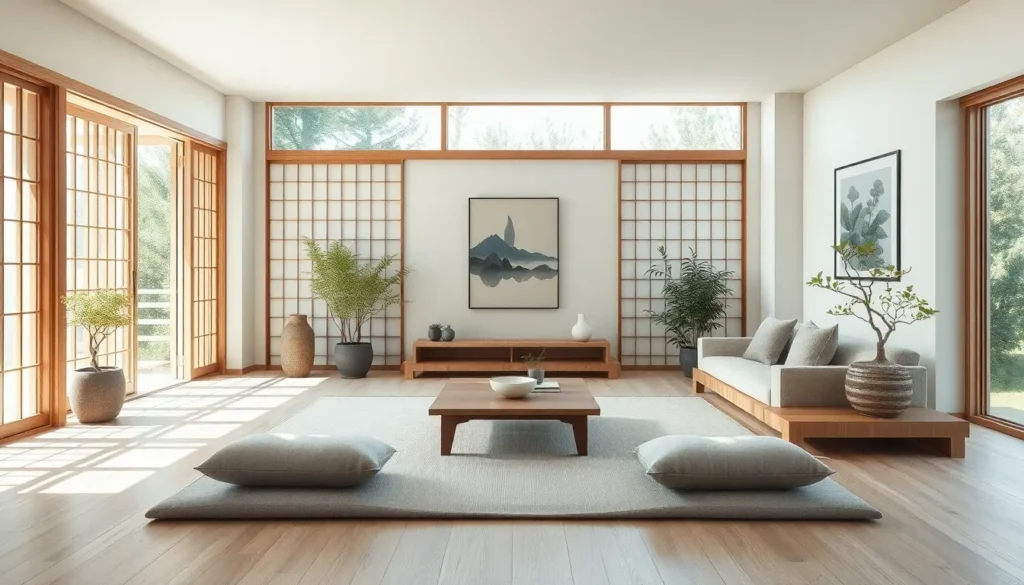We’ve all dreamed of creating that perfect zen-like sanctuary in our homes – a space where stress melts away and tranquility takes center stage. Japanese living room design offers exactly this kind of peaceful refuge through its masterful blend of minimalism natural elements and thoughtful functionality.
The beauty of Japanese interior design lies in its “less is more” philosophy. Every piece serves a purpose while contributing to an atmosphere of calm sophistication. From low-profile furniture and neutral color palettes to the strategic use of natural light and organic materials Japanese living rooms transform ordinary spaces into extraordinary retreats.
Whether you’re working with a small apartment or a spacious home we’ll explore how to incorporate authentic Japanese design principles that’ll revolutionize your living space. These time-tested concepts don’t just create visual appeal – they cultivate a lifestyle centered on mindfulness and intentional living that’s more relevant today than ever before.
Embrace Minimalist Furniture and Clean Lines
Japanese living room design revolves around the fundamental principle that furniture should serve a purpose without overwhelming the space. We achieve this harmonious balance by selecting pieces that embody simplicity and functionality.
Choose Low-Profile Seating Options
Low-profile seating creates the foundation of authentic Japanese living room aesthetics. Floor cushions called zabuton offer traditional comfort while maintaining the room’s open feel. We recommend placing these 18-inch square cushions directly on tatami mats or area rugs for an authentic experience.
Platform sofas sit closer to the ground than conventional Western furniture, typically measuring 12-16 inches in height compared to standard 18-20 inch sofas. Futons serve dual purposes as both seating and sleeping surfaces, making them ideal for smaller spaces. We suggest choosing futons with solid wood frames and natural cotton filling for durability and comfort.
Low coffee tables complement floor seating arrangements perfectly. These tables typically stand 10-14 inches high, allowing easy access while sitting on floor cushions. The reduced height creates visual continuity throughout the space.
Select Furniture with Natural Wood Finishes
Natural wood finishes bring warmth and organic beauty to Japanese living rooms. Light woods like bamboo, birch, and maple reflect the connection to nature that defines this design style. We prefer these materials because they create brightness while maintaining the serene atmosphere.
Bamboo furniture offers sustainability and lightweight construction. Bamboo grows 35% faster than traditional hardwoods, making it an environmentally conscious choice. The natural grain patterns add visual interest without creating distraction.
Cedar and cypress woods provide natural aromatherapy benefits through their subtle fragrances. These woods also resist moisture and insects naturally. We choose furniture with visible wood grain rather than painted or heavily stained pieces to maintain authenticity.
Avoid furniture with glossy finishes or artificial wood veneers. Matte and satin finishes preserve the natural texture while protecting the wood surface.
Incorporate Multi-Functional Storage Answers
Multi-functional storage maintains the clean aesthetic while maximizing space efficiency. Built-in shelving units serve as room dividers while providing display space for carefully curated items. We recommend installing these units floor to ceiling to create vertical storage without cluttering floor space.
Ottoman storage benches offer seating and hidden storage in one piece. These versatile items typically measure 16-18 inches in height, making them perfect for Japanese living room proportions. Choose ottomans with lift-top designs for easy access to stored items.
Tansu chests represent traditional Japanese storage furniture with multiple drawers and compartments. Modern versions adapt this concept using clean lines and natural finishes. We use these pieces to store electronics, books, and personal items while maintaining visual simplicity.
Wall-mounted floating shelves eliminate the need for bulky bookcases. Install these shelves at varying heights to create visual interest while keeping the floor area open. Three to four strategically placed shelves provide adequate storage without overwhelming the space.
Create a Neutral Color Palette with Natural Tones
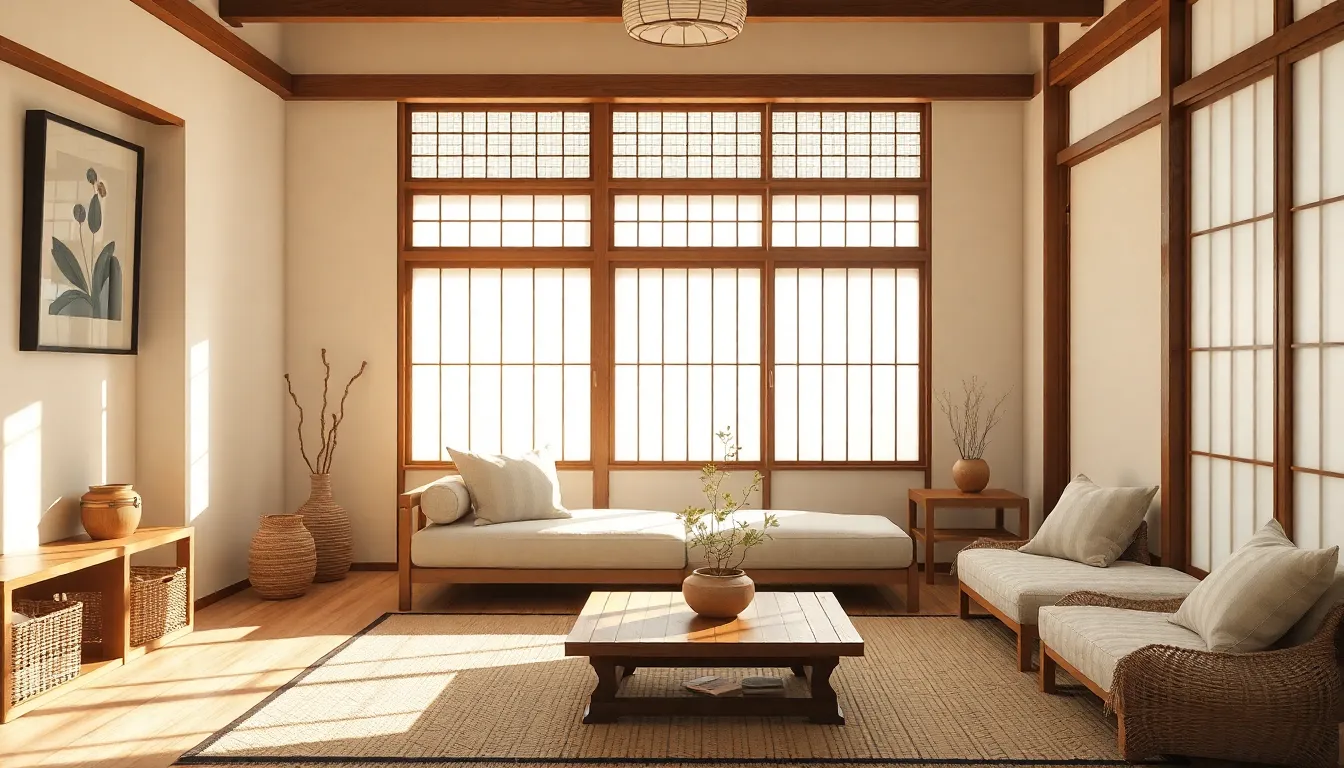
Building upon the minimalist foundation we’ve established, color selection becomes crucial for achieving authentic Japanese living room aesthetics. Natural tones create the serene backdrop that allows other design elements to shine while maintaining visual harmony.
Use Warm Whites and Soft Beiges as Base Colors
Warm whites serve as the perfect foundation for Japanese inspired spaces, creating an atmosphere of calm and serenity. We recommend choosing creamy off-whites rather than stark bright whites to maintain the organic feel essential to this design style.
Soft beiges complement warm whites beautifully by adding subtle depth without overwhelming the minimalist aesthetic. These neutral base colors allow natural materials like wood and bamboo to become the focal points of your living room.
Paint your walls in these gentle hues to establish a cohesive backdrop that flows seamlessly from room to room. Consider using warm white for larger wall surfaces and soft beige for accent walls or architectural details.
Layer different shades of these base colors through textiles and furnishings to create visual interest while maintaining the peaceful atmosphere. This approach prevents the space from feeling flat or monotonous.
Add Subtle Earth Tones Through Accessories
Earth tones introduce warmth through carefully selected accessories like woven baskets, natural fiber rugs, and live plants. We suggest incorporating muted browns, soft greens, and gentle terracotta shades that echo nature’s palette.
Woven baskets provide both storage and style while adding texture and earthy color to your neutral foundation. Choose pieces made from natural materials like rattan or bamboo to maintain authenticity.
Natural fiber rugs anchor seating areas with subtle earth tones that complement your base colors perfectly. Jute, hemp, and cotton rugs work exceptionally well in Japanese living rooms.
Plants bring life and natural green tones into the space without disrupting the serene color scheme. Consider adding small potted plants or a carefully placed bonsai tree to enhance the organic atmosphere.
Balance Light and Dark Elements
Light filtering through shoji screens creates soft illumination that perfectly balances natural brightness with cozy ambiance. We recommend using washi paper lamps to maintain this gentle lighting throughout the day.
Dark wooden accents provide necessary contrast against the neutral backdrop, preventing the space from appearing washed out. Low wooden tables and minimalist bookshelves add depth and visual weight.
Strategic placement of darker elements helps ground the room and creates focal points that draw the eye naturally. Consider a dark wood media console or a charcoal colored floor cushion as anchor pieces.
Natural light regulation through window treatments maintains the delicate balance between brightness and intimacy. Bamboo blinds or simple linen curtains allow you to control lighting levels throughout the day.
Integrate Natural Materials and Textures
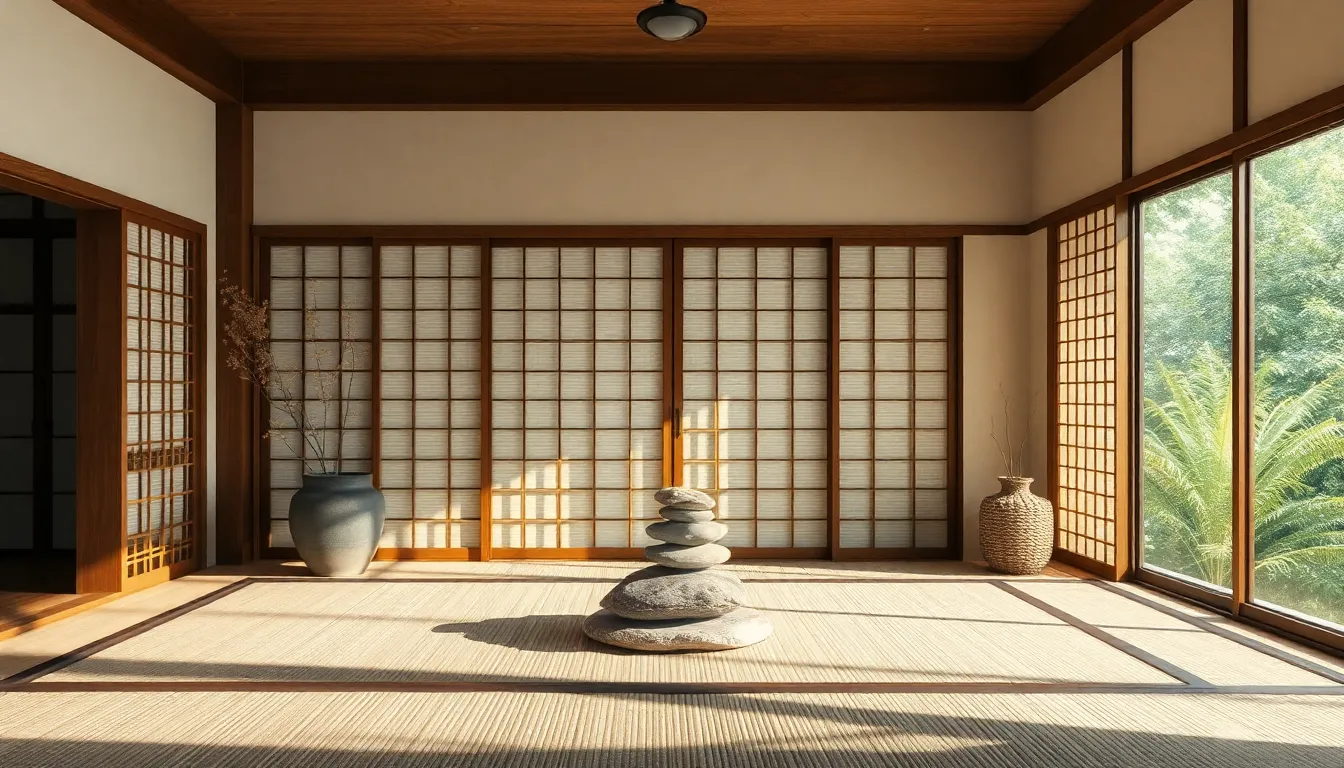
Natural materials form the foundation of authentic Japanese interior design, creating an immediate connection between indoor and outdoor environments. We’ll explore how incorporating organic textures transforms your living room into a serene retreat that embodies traditional Japanese aesthetics.
Add Bamboo Elements Throughout the Space
Bamboo screens create natural room dividers while maintaining the open flow essential to Japanese design. We recommend positioning these versatile pieces to separate seating areas without blocking natural light or creating visual barriers. Floor-standing bamboo dividers work particularly well in larger spaces where you need subtle separation.
Lighting fixtures made from bamboo add warmth and texture to your room’s ambiance. Consider pendant lights with bamboo shades or table lamps featuring woven bamboo accents to enhance the natural atmosphere. These elements cast beautiful shadows that change throughout the day, creating ever-changing visual interest.
Decorative bamboo accessories bring smaller touches of nature into your space. Incorporate bamboo plant holders, picture frames, or serving trays to reinforce the natural theme without overwhelming the minimalist aesthetic. These pieces should complement rather than compete with your existing furniture.
Include Stone and Wood Accents
Stone elements ground your living room with earthy textures that reflect Japanese garden principles. We suggest adding a small rock garden display or incorporating stone vases as focal points that draw the eye naturally. These accents create moments of contemplation within your living space.
Wood surfaces provide warmth and organic beauty through their natural grain patterns. Choose low coffee tables, floor cushion frames, or futon bases in light woods like bamboo, birch, or maple to maintain the airy feel of your room. These pieces should feature clean lines and minimal ornamentation.
Rough-hewn wood surfaces add textural depth while maintaining the natural aesthetic. Consider incorporating a live-edge wooden shelf or a table with visible wood grain to create visual interest without disrupting the calm atmosphere. These elements celebrate the natural imperfections that make each piece unique.
Use Natural Fiber Textiles and Mats
Tatami mats establish traditional Japanese seating areas that promote closeness to the ground and encourage mindful living. We recommend using these woven straw mats to define exact zones within your living room, creating intimate spaces for tea ceremonies or meditation. Traditional tatami sizing helps maintain proportional harmony in your room layout.
Cotton and linen textiles bring softness through their natural fibers and breathable qualities. Choose upholstery fabrics, throw pillows, and window treatments in these materials to add comfort while maintaining the organic theme. These textiles should feature neutral tones that complement your established color palette.
Jute and sisal floor coverings introduce additional texture layers that enhance the natural foundation of your room. These durable materials work well in high-traffic areas while adding visual warmth through their woven patterns. Place these mats strategically to define pathways or anchor furniture groupings within your space.
Design Flexible Spaces with Sliding Elements
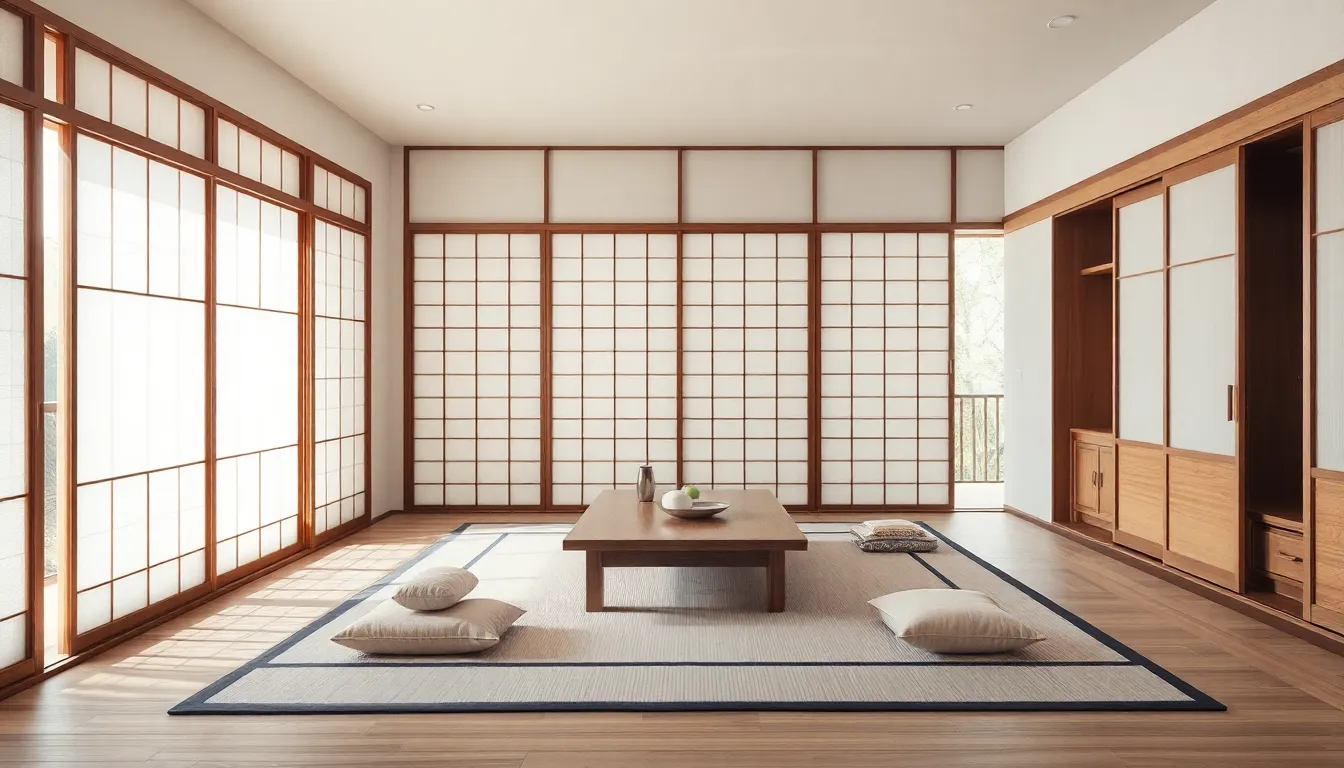
Flexible room arrangements become essential when we want to maximize our living space functionality. Moving elements transform our Japanese living room into adaptable environments that serve multiple purposes throughout the day.
Install Shoji Screens as Room Dividers
Shoji screens offer us the perfect balance between privacy and openness in our Japanese living room design. These traditional sliding panels filter natural light beautifully while creating distinct zones without completely separating spaces. We can position them strategically to divide our living area from dining spaces or create intimate reading nooks when needed.
Traditional shoji construction uses wooden frames with washi paper panels that diffuse light gently throughout our room. Installing floor-to-ceiling screens maximizes their visual impact and creates dramatic height in our space. We’ll find that these screens maintain the minimalist aesthetic while adding authentic Japanese elegance to our interior design.
Moving shoji panels allows us to reconfigure our room layout based on daily activities or entertaining needs. During gatherings, we can slide them completely open to create one large communal space. For quiet moments, we position them to create cozy private areas that enhance our mindfulness practice.
Use Sliding Doors for Storage Answers
Sliding storage doors help us maintain the clutter-free environment that’s essential to Japanese design philosophy. These space-saving answers conceal our belongings while preserving clean lines throughout our living room. We can install them on built-in cabinets, closets, or entertainment centers without sacrificing floor space.
Japanese storage principles emphasize hiding everyday items to maintain visual simplicity in our living spaces. Sliding doors allow us to access our storage quickly while keeping our room looking organized and peaceful. We’ll discover that these doors work particularly well for media equipment, books, and seasonal items that we don’t use daily.
Custom sliding door panels can match our existing woodwork or feature traditional Japanese patterns that enhance our overall design theme. Installing soft-close mechanisms ensures our doors operate smoothly and quietly, preserving the tranquil atmosphere we’ve created. We can choose from various materials including natural wood, bamboo, or paper panels that complement our neutral color palette.
Create Adaptable Seating Areas
Adaptable seating arrangements give us the flexibility to transform our living room for different occasions and group sizes. Low tables paired with zabuton floor cushions create traditional Japanese seating that we can easily rearrange or store away. This setup encourages intimate conversations and fosters community connection during gatherings.
Floor seating options like meditation cushions and portable backrests allow us to create comfortable arrangements without permanent furniture commitments. We can stack these pieces in designated storage areas when we need open floor space for activities like yoga or tea ceremonies. Modular seating elements give us countless configuration possibilities that adapt to our changing needs.
Traditional kotatsu tables provide warmth and gathering points that we can adjust seasonally in our living space. During warmer months, we remove the heating element and use the low table for casual dining or work activities. We’ll appreciate how these multifunctional pieces embody the Japanese principle of purposeful design while maximizing our room’s versatility.
Incorporate Traditional Japanese Design Elements
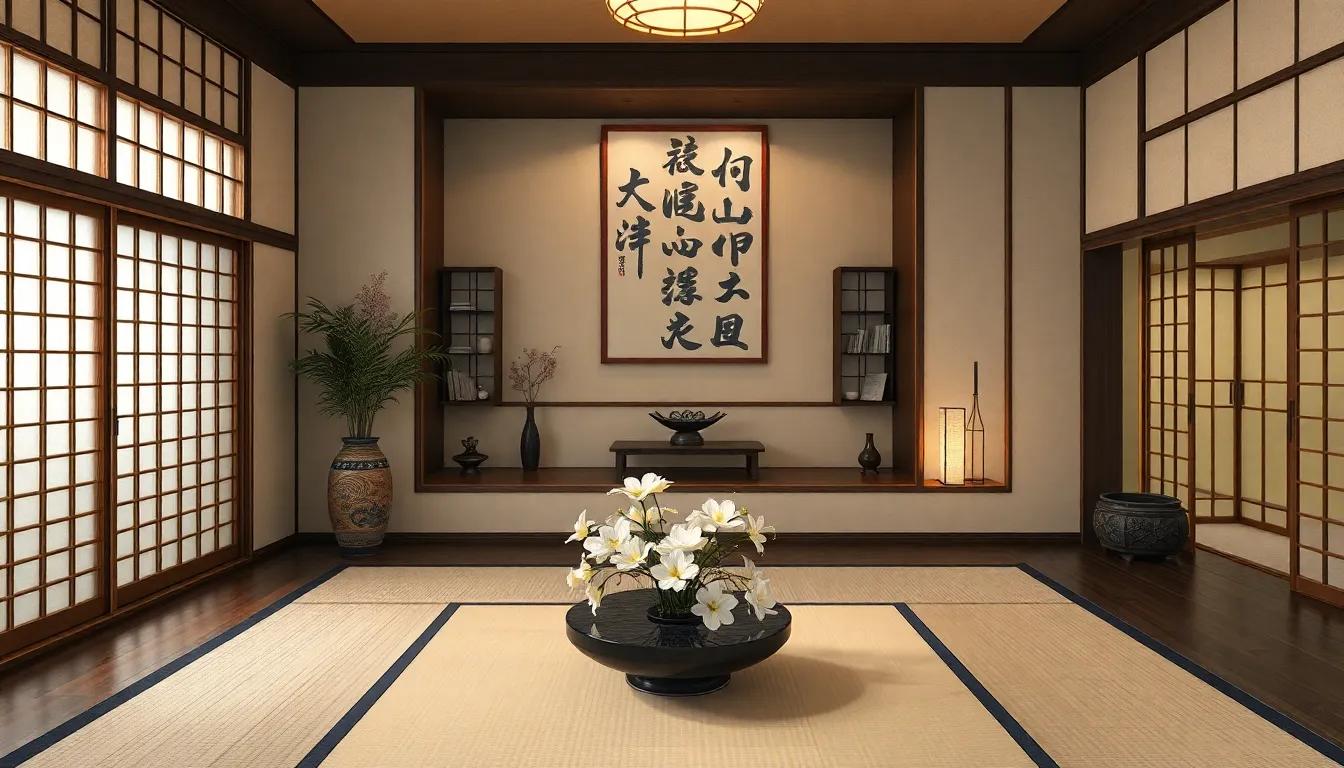
Building on the foundation of minimalist furniture and natural materials, we can deepen the authentic character of our living space by integrating exact traditional Japanese design elements that have shaped interior aesthetics for centuries.
Add a Tokonoma Display Alcove
Creating a tokonoma display alcove transforms any living room into a space that honors traditional Japanese culture while serving as a stunning focal point. This recessed alcove features a raised floor and provides the perfect backdrop for displaying art pieces such as calligraphy or ukiyo-e prints alongside traditional Japanese decorative items.
We recommend positioning the tokonoma along a main wall where it can be easily appreciated from multiple seating areas. Natural materials like wood enhance the alcove’s design and create visual harmony with other organic elements in the room. The elevated platform draws attention to displayed items while maintaining the clean lines essential to Japanese aesthetics.
Seasonal decorations work beautifully in a tokonoma setting, allowing us to refresh the space throughout the year with different pottery pieces, scrolls, or small sculptures. This rotating display keeps the living room ever-changing while respecting the traditional purpose of the alcove as a place for contemplation and artistic appreciation.
Include Tatami Mat Flooring Sections
Tatami mats made of woven grass or reeds bring authentic texture and warmth to Japanese living rooms while defining exact areas within the space. These traditional floor coverings create natural seating areas and help establish the low profile furniture arrangement that characterizes Japanese interior design.
We can use tatami mats to designate a meditation corner, tea ceremony space, or simply as comfortable flooring beneath our zabuton cushions and low tables. The natural materials provide insulation and cushioning while adding an organic element that connects us to traditional Japanese craftsmanship.
Partial tatami installation works well in modern homes, where we might cover a section of hardwood flooring to create a designated Japanese zone. This approach allows us to experience the authentic feel of tatami without committing to wall to wall coverage, making it easier to maintain and replace individual mats as needed.
Display Ikebana Flower Arrangements
Ikebana flower arrangements serve as living art pieces that emphasize harmony and balance with nature, making them essential elements in Japanese living room design. This traditional art form creates focal points that change with the seasons while bringing natural beauty indoors through carefully composed floral displays.
We can position ikebana arrangements in our tokonoma alcove or on low tables where they’ll be appreciated from floor level seating. The arrangements work best when they complement rather than compete with other decorative elements, maintaining the serene atmosphere that defines Japanese interiors.
Fresh branches, seasonal flowers, and carefully selected containers enhance the ikebana display while reflecting the Japanese principle of finding beauty in simplicity. These arrangements require regular attention and seasonal updates, which encourages us to stay connected with natural cycles and practice the mindfulness that Japanese design promotes.
Focus on Floor-Level Living and Seating
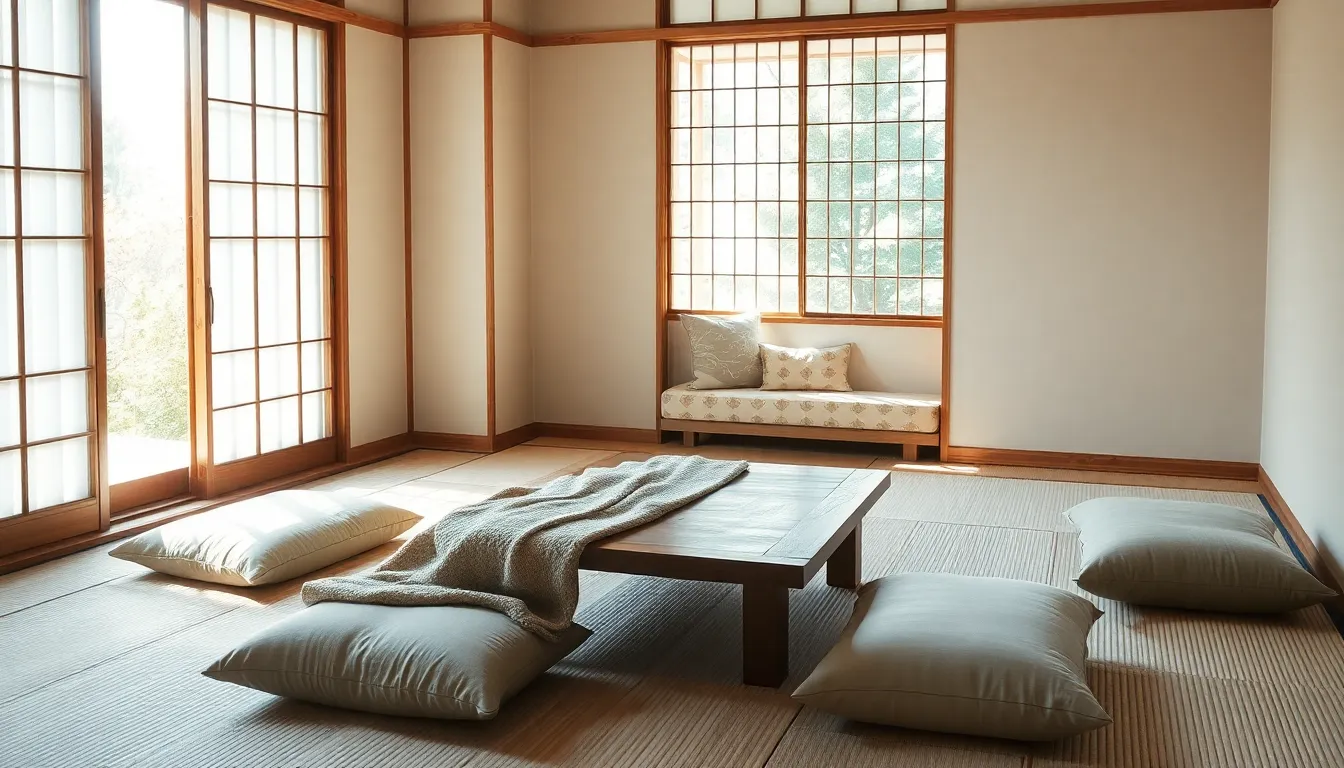
Building on the traditional design elements we’ve explored, floor-level living creates the authentic foundation of Japanese interior design. This approach encourages intimate social connections while maintaining the minimalist principles that make Japanese living rooms so serene.
Use Zabuton Floor Cushions
Zabuton floor cushions form the cornerstone of traditional Japanese seating arrangements. These square-shaped cushions are specifically designed for sitting on tatami mats and provide essential comfort for extended floor-level activities. Quality zabuton cushions feature firm yet supportive filling that maintains their shape while promoting proper posture during meditation or casual conversation.
We recommend choosing zabuton cushions in neutral colors like cream, beige, or soft gray to maintain the calming aesthetic we’ve established. Natural fabrics such as cotton or linen covers enhance breathability and connect with the organic materials throughout the space. Size typically ranges from 24 to 26 inches square, providing adequate support for adults while remaining proportional to low furniture pieces.
Arranging multiple zabuton cushions around low tables creates flexible seating zones that can accommodate different group sizes. Storage becomes effortless as these lightweight cushions stack neatly in closets or under raised platforms when not in use.
Choose Low Coffee Tables and Side Tables
Low coffee tables complement floor seating perfectly by maintaining the horizontal emphasis that defines Japanese living spaces. Traditional designs feature heights between 12 to 16 inches, allowing comfortable access while sitting on zabuton cushions. Wood construction remains the preferred choice, with light woods like bamboo, birch, and maple improving the natural warmth we’ve cultivated.
Surface area should accommodate tea service, books, or simple decorative elements without overwhelming the minimalist aesthetic. Clean lines and simple geometric shapes work best, avoiding ornate details that compete with the room’s peaceful atmosphere. We suggest tables with subtle storage compartments to maintain the clutter-free environment essential to Japanese design.
Side tables serve exact functional purposes while maintaining the low profile characteristic of this style. Placement near seating areas provides convenient surfaces for personal items like reading materials or ceramic tea cups. Heights should match or slightly exceed coffee table dimensions to create visual harmony across the space.
Create Comfortable Floor Lounging Areas
Comfortable floor lounging areas combine zabuton cushions with low tables to establish inviting social spaces. The traditional kotatsu heated table surrounded by blankets creates the ultimate cozy atmosphere for intimate gatherings during cooler months. This multifunctional piece encourages long conversations while providing warmth and comfort.
Layering different textures enhances the lounging experience without compromising simplicity. Soft throw blankets in natural fibers can be folded nearby for additional warmth, while small lumbar pillows provide extra back support during extended sitting periods. We recommend limiting accessories to maintain the clean aesthetic while ensuring maximum comfort.
Strategic placement near windows allows natural light to illuminate these gathering spaces during daytime use. Evening ambiance benefits from soft, diffused lighting through washi paper lamps or low-positioned floor lighting that doesn’t interfere with the intimate scale of floor-level activities.
Flexibility remains key to successful floor lounging areas. Lightweight furniture pieces allow easy reconfiguration for different occasions, from solo meditation sessions to larger social gatherings. This adaptability reinforces the functional beauty that makes Japanese living room design both practical and deeply satisfying.
Maximize Natural Lighting and Openness
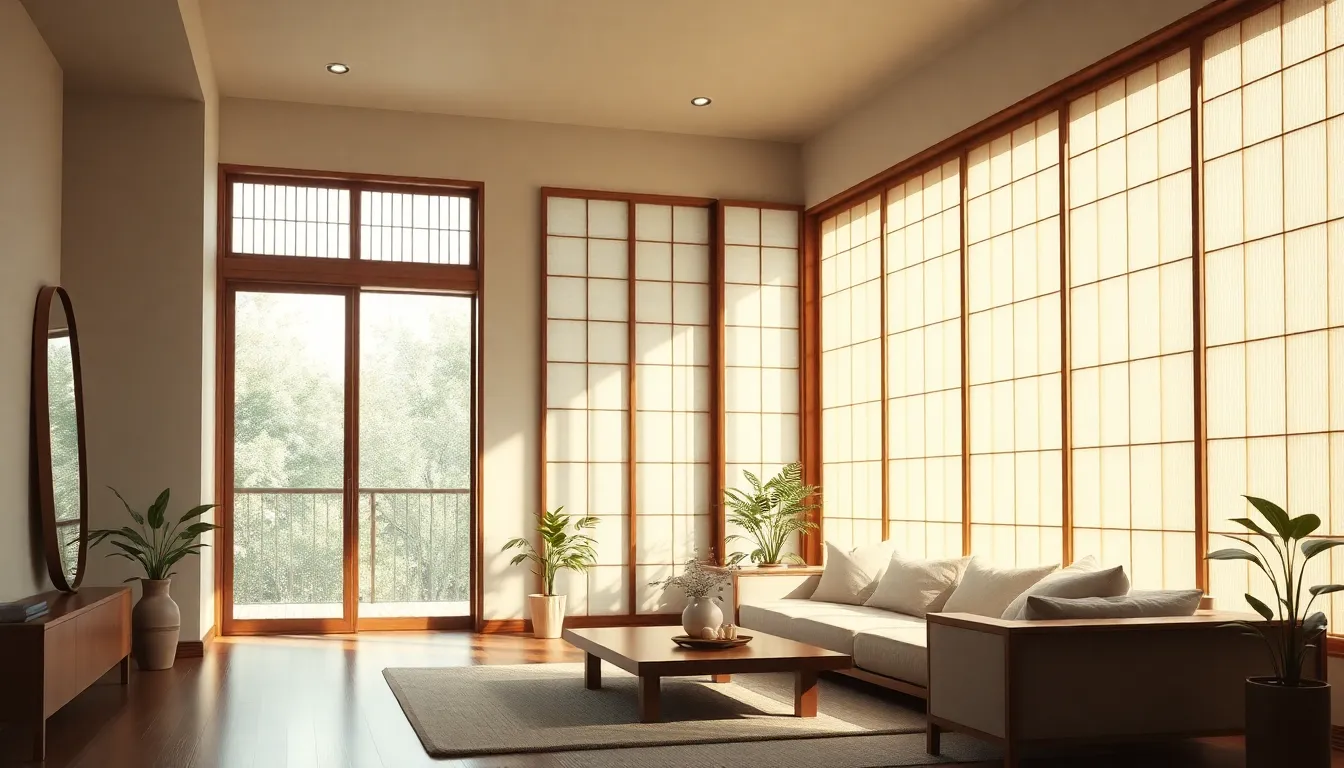
Natural light serves as the foundation of authentic Japanese interior design, creating the serene atmosphere that defines these peaceful living spaces. We’ll explore three essential techniques that transform ordinary rooms into bright, airy sanctuaries.
Use Translucent Window Treatments
Shoji screens represent the most authentic approach to filtering natural light in Japanese living rooms. These traditional translucent panels allow soft, diffused light to enter your space while maintaining complete privacy throughout the day. We recommend installing shoji screens as sliding panels or fixed window coverings to create that signature warm glow that makes Japanese interiors so inviting.
Paper screens work exceptionally well for rooms that receive harsh direct sunlight, transforming bright rays into gentle illumination. Traditional washi paper provides the most authentic look, though modern materials offer increased durability for high-traffic areas. We suggest measuring your windows carefully to ensure proper fit, as custom-sized shoji screens deliver the cleanest aesthetic.
Position Mirrors to Reflect Light
Mirrors amplify natural light by capturing and redirecting sunlight throughout your living space. We place large mirrors directly opposite windows to double the amount of natural light entering the room, creating an immediate sense of spaciousness. Strategic mirror placement works especially well in smaller Japanese-inspired living rooms where maximizing light becomes crucial.
Reflective surfaces positioned at angles can bounce light into darker corners, eliminating shadows that make spaces feel cramped. We recommend using mirrors with simple wooden frames or frameless options to maintain the minimalist aesthetic. Wall-mounted mirrors work better than standing mirrors, as they don’t interfere with the clean lines that define Japanese interior design.
Keep Window Areas Uncluttered
Clear window surroundings ensure that natural light flows freely into your living space without obstruction. We remove heavy curtains, bulky furniture, and decorative items from window areas to maximize light penetration. This approach aligns perfectly with the Japanese principle of intentional space usage.
Positioning low-profile furniture away from windows prevents blocking precious natural light sources. We arrange seating areas to take advantage of window light while maintaining clear pathways around these openings. Plants placed near windows should be minimal and carefully chosen to complement rather than compete with the natural lighting scheme.
Add Zen-Inspired Decorative Touches
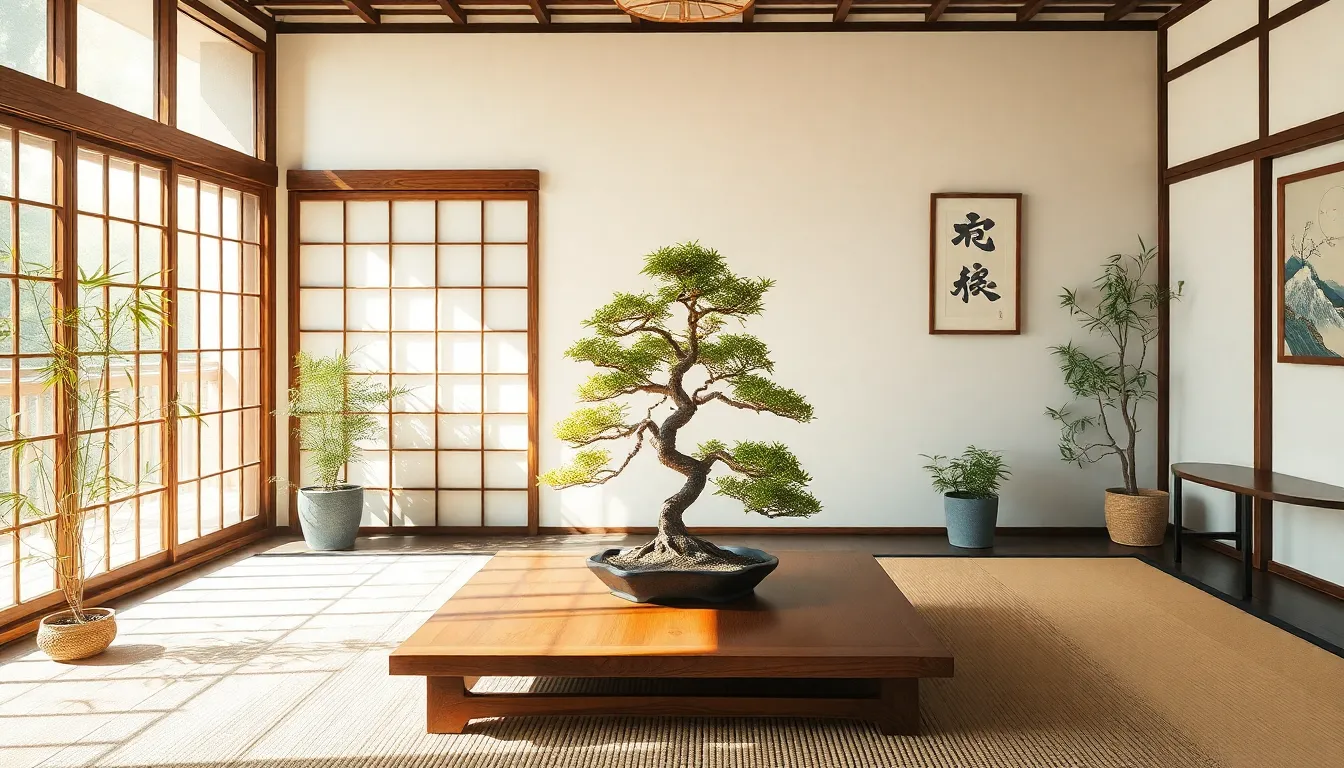
Zen-inspired decorative elements transform ordinary living spaces into serene sanctuaries that embody authentic Japanese design principles. We’ll explore exact touches that enhance the peaceful atmosphere while maintaining the minimalist aesthetic central to Japanese interior philosophy.
Include Indoor Plants and Bonsai Trees
Bonsai trees serve as living sculptures that symbolize harmony with nature and bring tranquil energy into our living spaces. These miniature trees represent the Japanese art of cultivating patience and mindfulness through careful nurturing. We recommend placing a single bonsai on a low table or dedicated stand where it can receive indirect natural light.
Bamboo plants offer vertical elements that complement the clean lines of Japanese furniture while requiring minimal maintenance. Fast-growing bamboo varieties create natural privacy screens when placed in corners or near windows. Ferns provide lush greenery that thrives in the filtered light conditions typical of Japanese living rooms.
Strategic plant placement enhances the room’s connection to nature without overwhelming the minimalist design. We suggest grouping plants in odd numbers and varying their heights to create visual interest. Small potted plants on floating shelves or window sills add life to the space while maintaining the uncluttered aesthetic.
Display Minimalist Artwork and Calligraphy
Ukiyo-e prints represent traditional Japanese artistry and add cultural authenticity to our living spaces through their elegant woodblock designs. These historical prints featuring landscapes, flowers, or seasonal themes complement neutral color palettes perfectly. We recommend selecting one or two pieces rather than creating a gallery wall to maintain the minimalist approach.
Calligraphy displays bring meditative energy through carefully chosen characters that represent peace, balance, or nature concepts. Vertical hanging scrolls work particularly well in Japanese living rooms because they draw the eye upward and create visual flow. Traditional black ink on white or cream paper provides the perfect contrast against neutral wall colors.
Simple framing techniques preserve the artwork’s integrity while supporting the clean aesthetic we’re creating. Natural wood frames in light finishes like bamboo or maple enhance the organic feel. We suggest leaving generous white space around pieces to allow them to breathe and command attention through their simplicity rather than elaborate presentation.
Use Natural Scented Elements
Traditional incense sticks create calming atmospheres through carefully selected fragrances that promote relaxation and mindfulness. Japanese incense varieties like sandalwood, cedarwood, and hinoki cypress connect us to nature while purifying the air. We recommend burning incense during evening hours when the family gathers for quiet activities.
Essential oil diffusers offer modern alternatives that provide consistent, gentle fragrance without visible smoke or ash. Natural scents like bamboo, green tea, or cherry blossom maintain the Japanese theme while supporting the clean air quality essential to healthy living spaces. Small ceramic or wooden diffusers blend seamlessly with other natural materials in the room.
Fresh elements like small bowls of dried flowers or aromatic wood pieces add subtle fragrance while serving as decorative accents. Cedar sachets placed in storage areas keep textiles fresh while contributing to the overall sensory experience. We find that combining multiple gentle scent sources creates layered aromatherapy that enhances the room’s peaceful atmosphere without becoming overwhelming.
Conclusion
Creating a Japanese-inspired living room offers us a pathway to tranquility and mindful living in our modern homes. We’ve explored how the careful balance of minimalist furniture natural materials and strategic lighting can transform any space into a peaceful sanctuary.
The beauty of Japanese design lies in its adaptability – we can incorporate these principles whether we’re working with a small apartment or spacious home. By focusing on functionality neutral colors and natural elements we create spaces that truly serve our well-being.
These timeless design principles remind us that our homes should be places of restoration and calm. When we embrace the Japanese philosophy of intentional living our living rooms become more than just spaces – they become sanctuaries that nurture our daily lives.
Frequently Asked Questions
What is the core philosophy behind Japanese interior design?
Japanese interior design follows the “less is more” philosophy, emphasizing minimalism, functionality, and natural elements. The style focuses on creating serene, tranquil spaces that promote mindfulness and intentional living through clean lines, neutral colors, and purposeful design choices.
What type of furniture works best in Japanese-inspired living rooms?
Low-profile furniture is essential for authentic Japanese design. Consider zabuton floor cushions, platform sofas, and low coffee tables. Choose pieces with natural wood finishes, particularly light woods like bamboo, birch, and maple, that serve multiple functions while maintaining clean aesthetics.
What colors should I use for an authentic Japanese color palette?
Stick to neutral colors with warm whites and soft beiges as your foundation. Balance light and dark elements throughout the space, and avoid bold or vibrant colors that can disrupt the peaceful atmosphere characteristic of Japanese design.
How can I maximize natural light in my Japanese-inspired space?
Use translucent window treatments like shoji screens to filter natural light while maintaining privacy. Position mirrors strategically to reflect light, keep window areas uncluttered, and arrange furniture intentionally to allow light to flow freely throughout the room.
What decorative elements enhance the Zen atmosphere?
Incorporate indoor plants like bonsai trees and bamboo for natural harmony. Add minimalist artwork such as ukiyo-e prints or calligraphy for cultural authenticity. Use natural scented elements like traditional incense or essential oil diffusers to create a calming, meditative atmosphere.
How do I maintain functionality while keeping the space minimal?
Choose multi-functional storage solutions like built-in shelving units and traditional tansu chests. Select furniture pieces that serve multiple purposes, and focus on items that combine beauty with practicality to maximize space efficiency without compromising the clean aesthetic.
What natural materials should I incorporate into my Japanese-inspired design?
Emphasize bamboo elements and stone accents to create connections between indoor and outdoor environments. Use natural wood finishes, washi paper for lighting fixtures, and organic textures that enhance the space’s authenticity while maintaining the minimalist approach.

